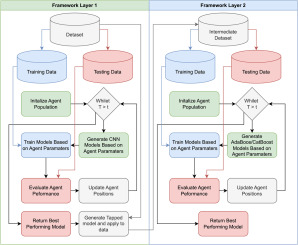Smart Investing in Metaverse Stocks: Your Ultimate Evaluation Guide

Navigating the metaverse: An Investor’s Guide to Emerging Opportunities
Understanding the metaverse: A New Digital Frontier
Before we explore investment strategies, it’s essential to clarify what the metaverse truly represents. It transcends the simplistic view of a mere video game; rather, it embodies a dynamic amalgamation of technologies, experiences, and business models. Envision it as a continuous, interconnected network of three-dimensional virtual realms where users engage with one another, digital entities, and AI avatars in real-time. The metaverse signifies a transformative shift in our online experiences, evolving from flat, two-dimensional interfaces to immersive, three-dimensional environments.
- Understanding the metaverse: A New Digital Frontier
- Key Technologies Driving the metaverse
- The metaverse Ecosystem: Diverse Investment Opportunities
- Adapting Traditional Financial Analysis to the metaverse
- Unique Evaluation Criteria for metaverse Investments
- User Engagement and Network Effects: The Core of Virtual Worlds
- Ecosystem Development and Interoperability: Creating Connections
- Intellectual Property and Innovation Pipeline: The Competitive Advantage
- Monetization Strategies: Pathways to Profitability
- Management Vision and Adaptability: Leadership Matters
- Navigating the Risks of metaverse Investing
- Building a metaverse Portfolio: Strategic Allocation and Diligence
- Conduct Thorough Due Diligence
- Conclusion: Investing Wisely in Tomorrow’s Digital Realities
Key Technologies Driving the metaverse
What underpins this expansive vision? Several core technologies serve as the foundation:
-
Virtual Reality (VR) and Augmented Reality (AR): These technologies create immersive experiences, merging the digital and physical realms. VR headsets offer complete immersion, while AR glasses overlay digital information onto the real world. Companies involved in producing these devices or developing the necessary display and sensing technologies are pivotal.
-
Blockchain and NFTs: These technologies are crucial for establishing digital ownership, facilitating secure transactions, and creating unique digital assets (Non-Fungible Tokens) that can be traded within virtual economies. They enable true scarcity and verifiable ownership in the digital landscape.
-
Artificial Intelligence (AI): AI enhances user experiences by powering intelligent virtual characters, personalizing content, and streamlining content creation in metaverse settings. It plays a vital role in making virtual environments feel vibrant and engaging.
-
High-Speed Connectivity (5G, Fiber): This infrastructure is essential for enabling smooth, low-latency interactions that are necessary for a fully immersive experience. Without robust connectivity, the metaverse would struggle to deliver a satisfying user experience.
-
Gaming Engines and 3D Tools: Platforms like Unity and Unreal Engine are fundamental for constructing and rendering the intricate virtual worlds and assets that populate the metaverse. These tools act as the digital building blocks of this new frontier.
Grasping these components is crucial, as investing in metaverse enterprises involves engaging with one or more of these foundational layers rather than focusing on a single platform.
The metaverse Ecosystem: Diverse Investment Opportunities
The metaverse is not a singular entity; it represents a vast, interconnected ecosystem. To effectively analyze metaverse stocks, one must understand the various segments that make up this burgeoning industry. Each segment presents unique opportunities and risk profiles.
-
Hardware and Devices: Companies in this category manufacture the physical tools that provide access to the metaverse, including VR/AR headsets (like Meta’s Quest series and Apple’s Vision Pro), haptic feedback devices, and specialized computing hardware such as advanced GPUs (e.g., Nvidia). Investing in this area means betting on the adoption of immersive technologies.
-
Software and Development Tools: These entities provide the essential platforms, engines, and tools that developers utilize to create virtual worlds and experiences. Notable examples include gaming engine developers (like Unity Software and Epic Games’ Unreal Engine) and firms that produce 3D modeling and animation software (such as Autodesk).
-
Virtual Platforms and Worlds: These are the actual environments where users gather, socialize, play, and conduct transactions. Examples include Roblox, Decentraland, The Sandbox, and Meta’s Horizon Worlds. These companies often support user-generated content and maintain their own virtual economies.
-
Content Creators and Experiences: This segment encompasses companies that develop games, entertainment, educational content, virtual fashion, and other digital assets within metaverse platforms. It is a highly fragmented and evolving space, often involving collaborations with established brands and independent creators.
-
Infrastructure and Connectivity: Companies that provide the foundational network infrastructure, cloud computing services, and cybersecurity solutions necessary for the metaverse to operate smoothly fall into this category. This includes telecom firms rolling out 5G, cloud service providers (like Amazon AWS and Microsoft Azure), and cybersecurity companies safeguarding virtual assets.
-
Services and Monetization: This includes companies that facilitate transactions, manage identities, or develop advertising solutions within the metaverse. Examples are payment processors for virtual currencies, NFT marketplaces, and agencies specializing in metaverse marketing.
Understanding these categories allows investors to identify how a company generates revenue and its role within the broader metaverse vision.
Adapting Traditional Financial Analysis to the metaverse
When evaluating metaverse stocks, conventional financial metrics still hold value, but their interpretation often requires adjustment, particularly for younger, growth-oriented companies. It’s akin to assessing a young tree by the same yield metrics as a mature one; both are trees, but they are at different growth stages.
-
Revenue Growth: This remains a critical metric. In an emerging sector, robust top-line growth signals increasing adoption and market share. Look for consistent, high double-digit or even triple-digit revenue growth. Is the company expanding its user base or increasing its average revenue per user?
-
Gross Margins: A healthy gross margin indicates that a company possesses pricing power and operates efficiently. This is especially important for software and platform companies that typically enjoy high margins once development costs are recouped.
-
Cash Flow from Operations (CFO) and Free Cash Flow (FCF): Many early-stage metaverse companies may be unprofitable due to significant investments in R&D and infrastructure. However, positive and growing CFO suggests that the core business is generating cash from its primary activities. While FCF may often be negative for high-growth tech firms, it indicates how much cash remains after capital expenditures, which is vital for long-term sustainability.
-
Balance Sheet Health: Evaluate debt levels, cash reserves, and the aforementioned burn rate. A strong balance sheet (low debt, ample cash) provides resilience during downturns and funds future innovation without excessive dilution or reliance on external financing.
Traditional valuation metrics like the Price-to-Earnings (P/E) ratio can be misleading. Many promising metaverse companies are still in their investment phase, prioritizing growth and market capture over immediate profitability. Therefore, they may exhibit high P/E ratios or even negative earnings. In such cases, investors often consider Price-to-Sales (P/S) ratios or Enterprise Value to Sales (EV/Sales) as alternatives, comparing them to industry peers and historical growth rates. The key is to recognize that you are often valuing future potential rather than current profits, which inherently carries risk.
Unique Evaluation Criteria for metaverse Investments
Since traditional metrics alone do not provide a comprehensive view for investing in metaverse companies, it is essential to explore criteria specific to this emerging digital landscape.
User Engagement and Network Effects: The Core of Virtual Worlds
In the metaverse, user metrics are paramount. Think of it as a social network—the value increases exponentially with more users.
-
Daily Active Users (DAU) / Monthly Active Users (MAU): These metrics reveal how many individuals actively engage with a platform. Consistent growth in DAU/MAU signals increasing adoption and the emergence of powerful network effects—the more users, the more appealing the platform becomes.
-
User Retention Rates: How many users return after their initial visit? High retention indicates a compelling and engaging experience, which is crucial for long-term viability.
-
Average Revenue Per User (ARPU): This metric illustrates how effectively a company monetizes its user base. A rising ARPU suggests successful monetization strategies, whether through in-app purchases, advertising, or premium subscriptions.
Ecosystem Development and Interoperability: Creating Connections
A thriving metaverse will be an interconnected web of experiences rather than isolated silos.
-
Partnerships and Collaborations: Look for companies forming strategic alliances with other tech firms, brands, content creators, or even other metaverse platforms. These partnerships can accelerate growth and build a more robust ecosystem.
-
Developer Community: For platform companies, a vibrant developer community is essential. The more creators building experiences and assets on a platform, the richer and more diverse the content will be, attracting more users.
-
Commitment to Interoperability: Does the company support standards that allow assets and identities to move between different virtual worlds? While challenging, interoperability is crucial for the metaverse’s long-term vision. Companies advocating for open standards and cross-platform compatibility may gain a competitive edge.
Intellectual Property and Innovation Pipeline: The Competitive Advantage
In a rapidly evolving technological landscape, strong intellectual property is vital.
-
Patents and Proprietary Technology: Does the company possess unique algorithms, software, or hardware that competitors cannot easily replicate? This creates a sustainable competitive advantage.
-
Content and Brand Strength: For companies focused on virtual experiences, strong existing brands or unique content libraries (like popular game franchises) can be significant competitive advantages.
Robust intellectual property and a solid innovation pipeline are essential for the long-term success of companies in this niche.
Monetization Strategies: Pathways to Profitability
Understanding how a company plans to achieve profitability is crucial. This could involve:
-
Advertising: In-world ads, sponsored content, and programmatic advertising within virtual spaces.
-
Digital Asset Sales: NFTs, virtual real estate, in-game items, and avatar customization.
-
Subscriptions: Access to premium content or exclusive features.
-
Transaction Fees: Earning a percentage from marketplace sales of digital goods or services.
Management Vision and Adaptability: Leadership Matters
Evaluate the quality of the management team. Do they have a clear vision for their role in the metaverse? Are they agile enough to adapt to rapidly changing technologies and market trends? A strong leadership team with a proven track record of innovation is crucial in nascent industries. Look for visionary leaders who also understand practical execution.
Navigating the Risks of metaverse Investing
While the metaverse holds immense potential, it also presents significant risks. A sound investment strategy must acknowledge these challenges.
-
High Volatility and Speculation: The metaverse market is still relatively small and speculative. Valuations can be influenced by hype cycles rather than established fundamentals, leading to extreme price fluctuations. Be prepared for rapid drawdowns and periods of uncertainty.
-
Technological Obsolescence: The pace of technological advancement is incredibly fast. Today’s cutting-edge hardware or software could be outpaced by new innovations tomorrow. This constant challenge requires companies to invest heavily in R&D, risking substantial capital.
-
Regulatory Uncertainty: The legal frameworks governing digital assets, virtual economies, data privacy, and intellectual property within the metaverse are still largely undefined and vary across jurisdictions. Changes could significantly impact business models and profitability.
-
Mass Adoption Hurdles: Despite the excitement, widespread consumer adoption faces significant challenges, including high hardware costs, potential poor user experiences, and concerns about digital addiction and privacy. The “killer app” that drives mass adoption may not yet exist.
-
Intense Competition: The space is attracting significant talent and capital, leading to fierce competition from both established tech giants and agile startups. Success requires strong differentiation and execution.
Building a metaverse Portfolio: Strategic Allocation and Diligence
Given the nascent and high-risk nature of metaverse investing, diversification is your best strategy. Think of it as exploring a new continent—you wouldn’t invest in just one small area.
-
Diversify Across Categories: Avoid concentrating your investments in one area. Spread your risk across hardware, software, platforms, content, and infrastructure companies to mitigate the risk of underperformance in any single segment.
-
Balance Pure-Plays with Established Giants: Consider allocating a portion to pure-play metaverse companies (higher risk, potentially higher reward) and another to established tech giants with significant metaverse initiatives (more stable, less direct exposure).
-
Start Small and Scale Up: Begin with a modest allocation to metaverse stocks, representing a percentage of your total portfolio that you’re comfortable losing. As the sector matures and clear winners emerge, you can gradually increase your exposure.
-
Continuous Monitoring: The metaverse is evolving rapidly. Regularly review your holdings and stay informed about industry trends, competitive landscapes, technological advancements, and regulatory changes. What is true today may change in six months.
Conduct Thorough Due Diligence
Never invest based solely on hype, social media trends, or a single news article. Conduct in-depth research on each company’s financials, management team, competitive advantages, and long-term vision before committing your capital. Understand their specific role and how they plan to achieve profitability in this new landscape.
Conclusion: Investing Wisely in Tomorrow’s Digital Realities
The metaverse offers one of the most thrilling yet intricate investment opportunities of our time. It promises to redefine how we interact, work, and play in digital spaces. By moving beyond initial hype and applying a rigorous, nuanced approach to evaluating metaverse stocks, you can position yourself to potentially benefit from its long-term growth. Focus on companies with strong underlying technology, high user engagement, clear monetization strategies, visionary leadership, and a commitment to building an open ecosystem.
Recognize the significant risks, diversify your portfolio thoughtfully, and commit to continuous learning. The metaverse is a marathon, not a sprint, and for the informed investor, the journey into its virtual depths could yield substantial rewards.







